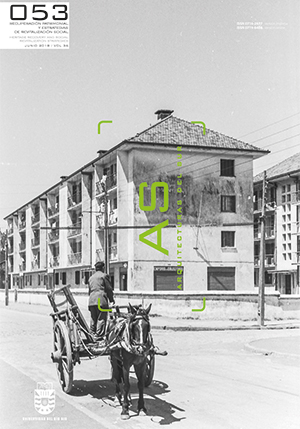Estudio de los significados del Mercado Central de Concepción para considerar en un futura recuperación patrimonial
DOI:
https://doi.org/10.22320/07196466.2018.36.053.05Palabras clave:
patrimonio, mercado, identidad, conservación de monumentos, culturaResumen
El Mercado Central de Concepción3 es un espacio de significación cultural, referente de la identidad, la arquitectura, la gastronomía y artesania local, en el que se desarrollaban diversas actividades tradicionales del centro de la ciudad de Concepción, y del cual se desconoce los significados consignados por individuos relacionados con el lugar. Precisamente el objetivo de este estudio es analizar –mediante entrevistas- el MCC a partir de los diferentes significados asignados por los actores vinculados a él, en aras de contribuir al entendimiento de este espacio y de aportar conocimiento para su recuperacion patrimonial. La metodología empleada es de naturaleza cualitativa, con enfoque descriptivo, en concreto, se emplea el análisis del discurso de los sujetos entrevistados. Una de las conclusiones más relevantes de este estudio fue establecer que el inmueble patrimonial MCC albergaba una práctica que actualmente no existe, develándose que el uso es lo más importante de este espacio. La preservación de ese uso debería considerarse en la futura recuperación del edificio.
Descargas
Citas
CONSEJO DE MONUMENTOS NACIONALES (CMN). Solicitud declaratoria como Monumento Histórico Mercado Central de Concepción, 2013, pp. 1-30.
DARMENDRAIL, Luis. Sobre el Mercado Central. Historia Arquitectónica de Concepción [en línea], 12 mayo 2013. [Consultado 2 diciembre 2017]. Disponible en: concehistorico.blogspot.com/2013/05/sobre-el-mercado- central.html
DELGADO, Manuel. Sobre Antropología, Patrimonio y Espacio Público. Revista Austral de Ciencias Sociales, 2006, n°10, pp. 49-66.
GARRÉ, Fabián. Patrimonio arquitectónico urbano, preservación y rescate: bases conceptuales e instrumentos de salvaguarda. Revista Conserva, 2001, n° 5, pp. 1-17.
GLITCHMAN. Mercado de Concepción (Fotografía 11 de 37) [en línea]. [Consultado 2 diciembre 2017]. Disponible en: http://mapio.net/place/7990618/
HAMILTON, Natalia. El Mercado Central de Concepción. Revista PAT, 2013, n° 57, pp. 66-69.
LOSADA, José María. Teoría y praxis de la conservación: el rol del historiador del arte. Boletín del Instituto Andaluz del Patrimonio Histórico, 1999, n°28, pp. 69-72.
MANZINI, Lorena. Estudios del patrimonio cultural: el significado cultural del patrimonio. Revista Sercam, 2011, no 6, pp. 27-42.
Mercado Central de Concepción, Téngase presente [en línea], 21 junio 2013. [Consultado 2 diciembre 2017]. Disponible en: http://tengasepresente.blogspot. com/2013/06/mercado-de-concepcion.html
OLIVER, Carlos. Libro de Oro de la Historia de Concepción: 5 de octubre 1550-1950. Concepción: Litografía Concepción, 1950.
OTZEN, Tamara y MANTEROLA, Carlos. Técnicas de muestreo sobre una población a estudio. International Journal of Morphology, 2017, vol. 35, no 1, pp. 227-232.
PASTORELLI, Giuliano. Mercado de Concepción: Incendio e incertidumbre en el destino de uno de los edificios más importantes de la ciudad. Plataforma Arquitectura [en línea], 29 abril 2013. [Consultado 17 diciembre 2017]. Disponible en: https://www.plataformaarquitectura. cl/cl/02-255735/mercado-de-concepcion-incendio-e-incertidumbre-en-el-destino-de-uno-de-los-edificios-mas-importantes-de-la-ciudad
TAYLOR, Steven y BODGAN, Robert. Introducción a los métodos cualitativos de investigación. La búsqueda de significados. Barcelona: Paidós Ibérica, 1984.
VALERA, Sergi. Análisis de los aspectos simbólicos del espacio urbano. Perspectivas desde la Psicología Ambiental. Revista de Psicología Universitas Tarraconensis, 1996, vol.18, no1, pp. 63-84.
WAISMAN, Mariana. El interior de la historia: historiografía arquitectónica para uso de latinoamericanos. Bogotá; Concepción, Chile: Escala; Universidad de Concepción, 1990.
ZAMBRANO, Vasthy (2018). Archivo personal en base a imagen del Google Maps. Realizado con el software photoshop 2018.
Descargas
Publicado
Cómo citar
Número
Sección
Licencia
El contenido de los artículos que se publican en cada número de Arquitecturas del Sur, es responsabilidad exclusiva de los autores y no representan necesariamente el pensamiento, ni comprometen la opinión de la Universidad del Bío-Bío.
Las/os autoras/es conservarán sus derechos de autoría, sin embargo, garantizarán a la revista el derecho de primera publicación y difusión de su obra. La publicación del artículo en Arquitecturas del Sur está sujeta a la Licencia de Reconocimiento de Creative Commons CC BY-SA que permite a otros Adaptar: remezclar, transformar y construir sobre el material para cualquier propósito, incluso comercialmente, Compartir: copie y redistribuya el material en cualquier medio o formato, siempre y cuando se reconozcan la autoría y la primera publicación en esta revista citando correctamente, así como también sus nuevas creaciones estén bajo una licencia con los mismos términos.













 Programa de Información Científica/Concurso Fondos de Publicación de Revistas Científicas 2018/ Proyecto Mejoramiento de Visibilidad de Revistas UBB (Código:FP180007)
Programa de Información Científica/Concurso Fondos de Publicación de Revistas Científicas 2018/ Proyecto Mejoramiento de Visibilidad de Revistas UBB (Código:FP180007) 
